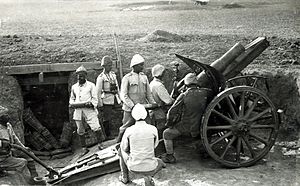| Sinai and Palestine campaign | |||||||||
|---|---|---|---|---|---|---|---|---|---|
| Part of the Middle Eastern theatre of World War I | |||||||||
 Ottoman artillerymen with a 10.5 cm Feldhaubitze 98/09 shortly before the Battle of Hareira and Sheria amidst the Southern Palestine offensive, 1917 | |||||||||
| |||||||||
| Belligerents | |||||||||
|
| |||||||||
| Commanders and leaders | |||||||||
|
|
| ||||||||
| Units involved | |||||||||
|
Force in Egypt (to March 1916)
| German Asia Corps | ||||||||
| Strength | |||||||||
|
1,200,000 (total)[1] |
Estimated 200,000–400,000
| ||||||||
| Casualties and losses | |||||||||
5,981+ died of disease French and Italian casualties: Unknown Total: 168,000+ casualties |
~40,900 died of disease
Total: 234,300+ casualties | ||||||||
The Sinai and Palestine campaign was part of the Middle Eastern theatre of World War I, taking place between January 1915 and October 1918. The British Empire, the French Third Republic, and the Kingdom of Italy fought alongside the Arab Revolt in opposition to the Ottoman Empire, the German Empire, and the Austro-Hungarian Empire. It started with an Ottoman attempt at raiding the Suez Canal in 1915 and ended with the Armistice of Mudros in 1918, leading to the cession of Ottoman Syria.
Fighting began in January 1915, when a German-led Ottoman force invaded the Sinai Peninsula, then occupied by the British as part of a "Protectorate" Protectorate of Egypt, to unsuccessfully raid the Suez Canal. After the Gallipoli campaign, British Empire veterans formed the Egyptian Expeditionary Force (EEF) and Ottoman Empire veterans formed the Fourth Army, to fight for the Sinai Peninsula in 1916. In January 1917 the newly formed Desert Column completed the recapture of the Sinai at the Battle of Rafa. This recapture of substantial Egyptian territory was followed in March and April by two EEF defeats on Ottoman territory, at the First and Second Battles of Gaza in southern Palestine.
After a period of stalemate in Southern Palestine from April to October 1917, General Edmund Allenby captured Beersheba from the III Corps. The Ottoman defences were captured by 8 November, and the pursuit began. EEF victories followed, at the Battle of Mughar Ridge, 10 to 14 November, and the Battle of Jerusalem, 17 November to 30 December. Serious losses on the Western Front in March 1918, during Erich Ludendorff's German spring offensive, forced the British Empire to send reinforcements from the EEF. The advance stalled until Allenby's force resumed the offensive during the manoeuvre warfare of the Battle of Megiddo in September. The successful infantry battles at Tulkarm and Tabsor created gaps in the Ottoman front line, allowing the pursuing Desert Mounted Corps to encircle the infantry fighting in the Judean Hills and fight the Battle of Nazareth and Battle of Samakh, capturing Afulah, Beisan, Jenin and Tiberias. In the process the EEF destroyed three Ottoman armies during the Battle of Sharon, the Battle of Nablus and the Third Transjordan attack, capturing thousands of prisoners and large quantities of equipment. Damascus and Aleppo were captured during the subsequent pursuit, before the Ottoman Empire agreed to the Armistice of Mudros on 30 October 1918, ending the Sinai and Palestine campaign. The British Mandate of Palestine and the Mandate for Syria and the Lebanon were created to administer the captured territories.
The campaign was generally not well known or understood during the war. In Britain, the public thought of it as a minor operation, a waste of precious resources which would be better spent on the Western Front, while the peoples of India were more interested in the Mesopotamian campaign and the occupation of Baghdad.[7] Australia did not have a war correspondent in the area until Captain Frank Hurley, the first Australian Official Photographer, arrived in August 1917 after visiting the Western Front. Henry Gullett, the first Official War Correspondent, arrived in November 1917.[8][9]
The long-lasting effect of this campaign was the Partitioning of the Ottoman Empire, when France won the mandate for Syria and Lebanon, while the British Empire won the mandates for Mesopotamia and Palestine. The Republic of Turkey came into existence in 1923 after the Turkish War of Independence ended the Ottoman Empire. The European mandates ended with the formation of the Kingdom of Iraq in 1932, the Lebanese Republic in 1943, the Hashemite Kingdom of Transjordan and Syrian Arab Republic in 1946, and the State of Israel in 1948.
- ^ Hart 2013, p. 409
- ^ Cite error: The named reference
Erickson71was invoked but never defined (see the help page). - ^ A brief record of the advance of the Egyptian Expeditionary Force under the command of Gen Sir Edmund Hynman Allenby 1919 London, pp. 94-107
- ^ Preston 1921, p. 193
- ^ Erickson 2007, p. 154
- ^ Erickson 2007, p. 241
- ^ Massey 1919, pp. 5–6
- ^ Hill 1983
- ^ Pike 1983
Cite error: There are <ref group=Note> tags on this page, but the references will not show without a {{reflist|group=Note}} template (see the help page).